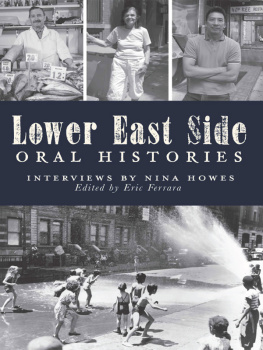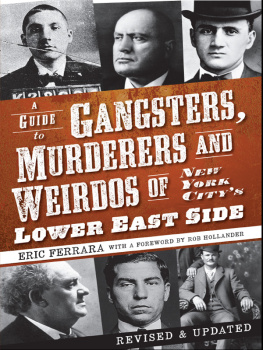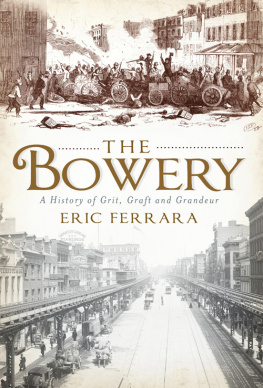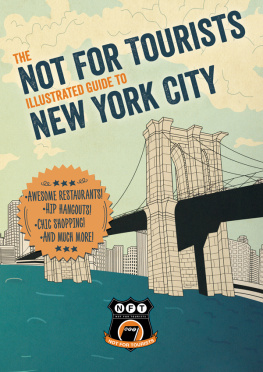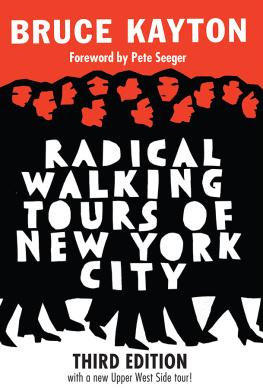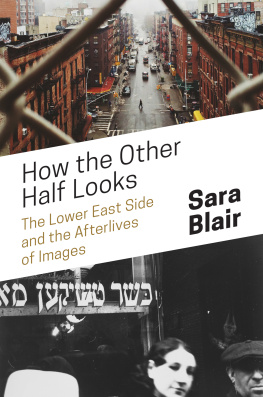

Published by The History Press
Charleston, SC 29403
www.historypress.net
Copyright 2012 by Eric Ferrara and Nina Howes
All rights reserved
First published 2012
e-book edition 2012
Manufactured in the United States
ISBN 978.1.61423.752.5
Library of Congress CIP data applied for.
print ISBN 978.1.60949.794.1
Notice: The information in this book is true and complete to the best of our knowledge. It is offered without guarantee on the part of the authors or The History Press. The authors and The History Press disclaim all liability in connection with the use of this book.
All rights reserved. No part of this book may be reproduced or transmitted in any form whatsoever without prior written permission from the publisher except in the case of brief quotations embodied in critical articles and reviews.
This book is dedicated to the generations of people whose dreams, sacrifices and creativity have made the Lower East Side such a unique and wonderful soul brew.
CONTENTS
ACKNOWLEDGEMENTS
We would like to thank the following people: Terry Gregory at Educational Alliance, Sirovitch Senior Center; Morgan Jenness, formerly at New York Theatre Workshop; Carlos Jerome at Around the Block; Elizabeth Ruf at Theater for the New City; Jeana Musacchio at Cabrini Center for Nursing & Rehabilitation; Alex Roe at Metropolitan Playhouse; Angie Salgado at Lillian Wald Senior Center; Fern Schwartz at Educational Alliance, Whittaker Senior Center; Hanya Krill at the Ukranian Museum; and all the participants who shared their life stories.

Children cooling off at a fire hydrant in August 1943. Courtesy of the Library of Congress.
INTRODUCTION
This project was born in the summer of 2000, during New York Theatre Workshops Community Day. Morgan Jenness, the associate artistic director, spoke about the importance of oral histories in bringing history to life. And I thought, Yes! This is for me. A few months later, I saw a huge construction crane cutting the sky at Tenth Street and Second Avenue. I had never seen a crane on the Lower East Side before. I knew I had to act fast.
The neighborhood as I had known it was changing. I had to get stories before they were gone. At first I started with friends and friends of friends. Then I started going into stores and community centers. I interviewed over sixty people from various backgrounds: Puerto Rican, Ukrainian, Polish, Austrian, German, Italian, Indian, Chinese and African American. The stories spanned the time from the 1920s through the 1970s. They were edited for clarity, but each persons unique voice was left intact.
Each story is distinct. Even people who lived on the same block had different perceptions, but most everyone agreed they wouldnt trade growing up on the Lower East Side for anythingeven with the hardships. And were talking about the days when if you wanted a bath, you had to go to the public baths and pay a nickel. There was no central heating; you had to get coal or find wood for the stove.
Soon the streets became alive for me. I began to see the horses and pushcarts crowding on Houston Street, the boys playing stickball, the women rushing to work in factory lofts on Broadway. And by the East River, I could see the docks busy with ships and cargo and kids trying to steal a piece of coal when the guard wasnt looking. I could hear the congas pounding through the thick summer air and feel the steam of the water hydrants splashing on the tar streets. But more than these images, and what I loved most, was meeting people whose spunk, diversity and perseverance made the Lower East Side a soul brew.
While looking for a publisher, I had the fortune of meeting Eric Ferrara. Both sides of his family lived in the neighborhood for over a century, and his work in the communityas an author and with the Lower East Side History Projectmade him appreciate the value of these interviews. His experience helped shape the project.
Ive been around the Lower East Side for over forty years. In 2007, I was evicted from my charming but funky walk-up apartment where I lived for twenty years. The building was sold for $4.5 million to a real estate developer who lived in Europe. None of us had proper leases. I tried to rally my fellow tenants to action, but despite my efforts, we were put out. After that, the interviews took on a new meaning. I couldnt wait to get to them.
They made me remember the Lower East Side as I had known it. They made me smile and sometimes cry. They helped me to learn how people talk, how people remember and how people survive.
Nina Howes
FRANKIE ALEXANDER
Interviewed in February 2001 at a coffee shop at Nineteenth Street and First Avenue
I was born in 1951 and named Frank Alexander Martinez. As an actor, I had difficulty getting cast because they thought I was Puerto Rican, and I dont look Puerto Rican. So I dropped my last name. My parentsmy fathers from Peru and my mothers from Cubathey originally came to this country for a better life just as a lot of other immigrants did.
When I was little, my father worked at a dinerin the kitchen, the grilland washed the dishes. My mother was a housewife. My parents lived on the Lower East Side. We moved around quite a bit. I remember Sheriff Street. I was always looking out the window cause we were directly across the street from the Williamsburg Bridge. It was the subways going by, and the cars. And there was also a walkway for pedestrians. I remember those sounds. For some reason, it didnt affect me. So Id always be looking at people going by in the cars, in the trains.
It was predominantly a Jewish neighborhood. My apartment was a walk-up on the fifth floor. It was a big haul going up and down those steps. In the summertime, we didnt have air conditioning or a fan either. How we survived those hot and humid summers, I cant imagine.
We didnt have extra money for shopping, but my mother would take me to Kleins on Fourteenth Street because of the air conditioning. It was nice and cool in there. My father, he liked rock and roll, doo-wop and stuff. Listened to it on his portable radio. Once we saw these teenagers in the hall. They were smoking, and my mother was afraidthis was the time of street gangsand all of a sudden they started harmonizing. They were doing doo-wop right in the hall. It was because of the echo. And I remember my mother applauding, and they bowed. And some of them had the pompadoursthe hair up and slick. Like the Elvis Presley look.
In the summertime, the kids used to open up the hydrants, and they used to cut out the cans. And there were a lot of beer cans. Rheingold was the top beer; it had a red label. And they had a Miss Rheingold. Theyd open up the cans, both ends, and put it in front of the running water. Theyd hold on to it, and it was like a hose. They used to spray it all over.
I remember my mother; she used to do our wash in the sink with a scrubbing board. And my father set up this clothesline from the back of our building to another building across the way. Everybody would hang their clothes out on the line. It was great in the summertime. In the winter it was something else. One time my mother pulled in the clothes and my jeans were stiff; they were frozen.
Later on, that building was being knocked down, so we had to move. We went to East Ninth Street between First and Avenue A. There were no trees at all on that block. You wanted trees, you go to the park. The reason we got that apartment was because my father was going to be the super. He was getting rent free, and he was getting twenty-five bucks a week. Plus he had his baker job, so he was ecstatic.
Next page
